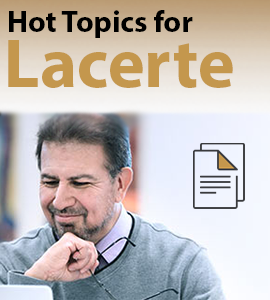- Topics
- Training
- Community
- Product Help
- Industry Discussions
- User Groups
- Discover
- Resources
- Intuit Accountants Community
- :
- Lacerte Tax
- :
- Lacerte Tax Discussions
- :
- Re: Oil and gas partnerships
Oil and gas partnerships
- Mark Topic as New
- Mark Topic as Read
- Float this Topic for Current User
- Bookmark
- Subscribe
- Printer Friendly Page
- Mark as New
- Bookmark
- Subscribe
- Permalink
- Report Inappropriate Content
Where is everyone entering data labeled 20 AH1-AH9 in the Lacerte program?
Thanks,
Janet
Best Answer Click here
![]() This discussion has been locked.
No new contributions can be made. You may start a new discussion
here
This discussion has been locked.
No new contributions can be made. You may start a new discussion
here
Accepted Solutions
- Mark as New
- Bookmark
- Subscribe
- Permalink
- Report Inappropriate Content
So your client owns ET directly, and ET's K-1 reports three PTP activities: ET, USAC, and SUN.
AH1 is UBTI. If UBTI isn't relevant to your client, you ignore it. If it is relevant, someone else should be preparing your client's return. Also, the ant-type instructions tell you exactly what to do with it.
AH2 is UBTI. If UBTI isn't relevant to your client, you ignore it. If it is relevant, someone else should be preparing your client's return. Also, the ant-type instructions tell you exactly what to do with it.
AH3 is the adjustment for bonus depreciation for states that didn't conform to bonus depreciation. The ant-type instructions on the State Information schedules talk about this. Their position is that "if a bonus depreciation adjustment applies to your situation," this is the adjustment amount. The typical PTP position is that you use it if your client is resident in a non-conforming state. You should know if your client's state conforms to bonus depreciation and be able to use professional judgement here.
AH4 is the gain portion of the adjustment for bonus depreciation for states that didn't conform to bonus depreciation. Same theory as AH3.
AH5 is the AMT portion of the adjustment for bonus depreciation for states that didn't conform to bonus depreciation. Same theory as AH3.
AH6 is state taxes paid at the partnership level and deducted in arriving at Box 1. If your client's amounts are greater than zero, the amount invested is very very large, and you shouldn't be asking random strangers on the internet how to do the tax return. That said, the only thing I can think it might be relevant to would be some state that made you add it back.
AH7 is gross receipts. If you don't worry about gross receipts for any other partnership your client might be invested in, why are you starting now? If your client were a business entity, you'd need it to calculate apportionment percentages.
AH8 is a nontaxable adjustment to capital account. If there's an amount other than zero here, which there isn't, it would help you reconcile any differences between outside basis and capital account.
AH9 is an E&P adjustment. If E&P is a relevant concept to your client because they are a C-corp, this is the adjustment amount.
Lacerte is not a "plunk in numbers and out pops a tax return" software, and PTP investments don't give you numbers conducive to being plunked in anywhere. It takes time to make sure you understand the information on the K-1, so you can make input that gives you the output you want - which sometimes involves more than matching the code on the K-1 with the code in the Lacerte input screen. Your client should be paying you a minimum of $300 a year extra ($100 per activity) just for owning that dumb thing, plus an extra $200 in the year of a total disposition and an extra $500 in the year of a partial disposition, because they are a PITA and doing them right really takes that long. So give your client a heads-up about the consequences of their poor life choice and go find some CPE on PTP taxation.
- Mark as New
- Bookmark
- Subscribe
- Permalink
- Report Inappropriate Content
AH is just "other information." There's no O&G-specific standard that says "this item should be called AH2."
If you tell me what information you have, I can probably tell you the significance of it. If the amounts are material, it's not a PTP / MLP, and your client is not obviously the designated sucker in the deal, I will probably also tell you that you're doing your client a disservice by preparing the return, but most of the time one of those three outs apply.
- Mark as New
- Bookmark
- Subscribe
- Permalink
- Report Inappropriate Content
Hi Phoebe,
The amounts are not significant but they are PTP's. Are you saying that we don't have to enter O&G partnership K1's?
Thanks,
Janet
- Mark as New
- Bookmark
- Subscribe
- Permalink
- Report Inappropriate Content
I'm not saying anything of the sort!
Which PTPs are they? I've got K-1s for most of them and can look myself to see what fields you're looking at, rather than you typing everything out.
- Mark as New
- Bookmark
- Subscribe
- Permalink
- Report Inappropriate Content
ET, USAC, SUN
- Mark as New
- Bookmark
- Subscribe
- Permalink
- Report Inappropriate Content
So your client owns ET directly, and ET's K-1 reports three PTP activities: ET, USAC, and SUN.
AH1 is UBTI. If UBTI isn't relevant to your client, you ignore it. If it is relevant, someone else should be preparing your client's return. Also, the ant-type instructions tell you exactly what to do with it.
AH2 is UBTI. If UBTI isn't relevant to your client, you ignore it. If it is relevant, someone else should be preparing your client's return. Also, the ant-type instructions tell you exactly what to do with it.
AH3 is the adjustment for bonus depreciation for states that didn't conform to bonus depreciation. The ant-type instructions on the State Information schedules talk about this. Their position is that "if a bonus depreciation adjustment applies to your situation," this is the adjustment amount. The typical PTP position is that you use it if your client is resident in a non-conforming state. You should know if your client's state conforms to bonus depreciation and be able to use professional judgement here.
AH4 is the gain portion of the adjustment for bonus depreciation for states that didn't conform to bonus depreciation. Same theory as AH3.
AH5 is the AMT portion of the adjustment for bonus depreciation for states that didn't conform to bonus depreciation. Same theory as AH3.
AH6 is state taxes paid at the partnership level and deducted in arriving at Box 1. If your client's amounts are greater than zero, the amount invested is very very large, and you shouldn't be asking random strangers on the internet how to do the tax return. That said, the only thing I can think it might be relevant to would be some state that made you add it back.
AH7 is gross receipts. If you don't worry about gross receipts for any other partnership your client might be invested in, why are you starting now? If your client were a business entity, you'd need it to calculate apportionment percentages.
AH8 is a nontaxable adjustment to capital account. If there's an amount other than zero here, which there isn't, it would help you reconcile any differences between outside basis and capital account.
AH9 is an E&P adjustment. If E&P is a relevant concept to your client because they are a C-corp, this is the adjustment amount.
Lacerte is not a "plunk in numbers and out pops a tax return" software, and PTP investments don't give you numbers conducive to being plunked in anywhere. It takes time to make sure you understand the information on the K-1, so you can make input that gives you the output you want - which sometimes involves more than matching the code on the K-1 with the code in the Lacerte input screen. Your client should be paying you a minimum of $300 a year extra ($100 per activity) just for owning that dumb thing, plus an extra $200 in the year of a total disposition and an extra $500 in the year of a partial disposition, because they are a PITA and doing them right really takes that long. So give your client a heads-up about the consequences of their poor life choice and go find some CPE on PTP taxation.
- Mark as New
- Bookmark
- Subscribe
- Permalink
- Report Inappropriate Content
Just a cheer for that response is NOT enough...
Please tell me you at least had to refer to the instructions to list all that, rather than reciting from memory 😂
- Mark as New
- Bookmark
- Subscribe
- Permalink
- Report Inappropriate Content
I have clients in ET, so I could literally look at the K-1! Which is good, because even with the same firm preparing them, there's not so much standardization of the supplemental information. And the description of what each line-item is is written right next to each code, not even in ant-type.
- Mark as New
- Bookmark
- Subscribe
- Permalink
- Report Inappropriate Content
Thank you!! I've been trying to get edumacated on O&G for years but can't seem to find anything. Now it's too late, I'm retiring.
Janet





